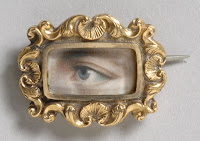Although fashion trends have been around as long as fashion itself, one of the most interesting I have found is the affinity Georgians had for wearing lover’s eye jewelry. These tiny miniature portraits of one’s lover’s eye adorned countless pairs of lovers during the latter end of the 18th century.
The trend was started in the mid-1780s by none other than George, Prince of Wales, soon to become the Prince Regent or “Prinny” and eventually George IV. But in the late 18th century, George was a man in love—with the wrong woman. She was Maria Fitzherbert, a Catholic widow who he was forbidden to marry due to the Act of Settlement. This decree did not, however, deter George. In 1785 he sent his love a picture of his own eye, painted in water colors on a tiny piece of ivory along with a marriage proposal, stating, “I send you a proposal and at the same time I send you an Eye.”
The couple were wed—illegally—shortly afterward, and thus began a mania for these small likenesses, called Lover’s Eyes. They were usually painted on ivory and made into all kinds of jewelry: lockets, rings, pins, charms, brooches. As the pieces were all no biggerthan a pinkie nail even when embellished with priceless gems, they were perfect as secret tokens of one’s undying love. All one had to do was keep the tiny portrait close and you could look into the eye of your loved one anytime of the day or night.
Why the craze for a single part of a portrait? Why not the entire likeness? Hanneke Grootenboer, a student of the artistic eyes, and author of the book Treasuring the Gaze: Intimate Vision in Late Eighteenth Century Eye Miniatures that “people were desperate to give each other not just images of themselves, but part of themselves.” The tiny eyes were small enough to cradle in a hand and could evoke the illusion of one’s lover staring lovingly up at them.
For some unknown reason, the fashion was a short lived one. By 1830 lover’s eyes had been supplanted by the newest fad: photography. With the advent of true portraits, the paintings of the lover’s eyes ceased almost overnight and they were largely forgotten until just after the year 2000 when researchers began to uncover their history. Only about 1000 lover’s eyes are still in existence. The best collections are those in The Cleveland Museum of Art, The Philadelphia Museum of Art, and the Victoria and Albert Museum in London.
Sources:
Gotthadrt, Alexxa. “The Mysterious History of Lover’s Eye Jewelry.” Visual Culture. January 4, 2019.
Roderick, Kyle. “Lover’s Eyes: Jewelry’s Sexiest Sub-Genre, Luxuriously Reinterpreted by Ana Katarina.” Forbes, March 8, 2019.
Silver, Carly. “19th Century Lover’s Eye Jewelry Was the Perfect Accessory for Secret Affairs.” Atlas Obscura, February 15, 20127





